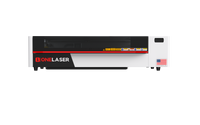If you’ve ever struggled with laser cut burn marks, charred edges, or those annoying smoky residues on the back of your materials, you’re definitely not alone. Burn marks are one of the most common frustrations in the laser-cutting world, especially when working with wood, paper, fabric, and other burn-prone materials.
The good news? Burn marks are not unavoidable. In fact, with the right setup and a few strategic adjustments, you can dramatically reduce burn marks, or even eliminate them entirely.
Key Takeaway
In this comprehensive guide, we’ll walk you through how to get rid of laser cut burn marks, how to prevent burn marks when laser cutting, and even how to remove burn marks from laser cut wood if they’ve already happened. These are the same practical fixes we use in our own shop to get consistently clean, professional-looking results.
Whether you're a beginner or an experienced maker, this guide will help you achieve laser cutting without burn marks using simple tools and clever techniques.
1. Why Laser Cut Burn Marks Happen
Before we get into the solutions, it’s important to understand why burn marks appear in the first place.
During cutting, your laser beam travels downward through the material and into the cutting bed. Most laser machines use a honeycomb platform, which is incredibly useful for supporting materials, but it also reflects some of the laser beam back upward.

These reflected beams can hit the underside of your material, leaving:
- Brownish scorch marks
- Charred spots
- Heat-fogged areas
- Unwanted residue
This is especially visible on lighter materials like basswood, birch plywood, paper, felt, and non-woven fabrics.
Over time, this reflection-based scorching can significantly affect product appearance and reduce the perceived quality of your work.
Fortunately, the fix is straightforward, just reduce reflection and minimize the contact between the material and the cutting bed.
2. What You’ll Need for Cleaner Cuts
To follow the four methods in this guide, you only need a few common tools and materials:
- Computer with LightBurn software
- Knife strip
- 8 magnets
- Basswood board
- Nonwoven fabric
- Textured paper
These items will allow you to set up proper spacing, support, and protection between your material and the honeycomb bed, resulting in fewer burn marks and better-looking cuts.
3. 4 Effective Methods to Reduce Laser Cut Burn Marks
Here are the exact techniques we use in our workshop. Some methods prevent burn marks entirely, while others help minimize marks that do occur.
Let’s dive in.
3.1 Method 1: The Knife Blade Platform
When cutting wood or other firm materials, using a knife blade platform is one of the most effective ways to reduce scorch marks.
Why It Works
Knife blade platforms have long, narrow blades with upward-facing sharp edges. These edges provide minimal contact area, meaning the underside of your material barely touches the platform at all.
With almost no contact, the chances of reflected beams burning the backside are dramatically reduced.

How to Set It Up
You can place the blades in two ways:
- Vertically , for strong support
- Horizontally , for wider distribution
- Always ensure the sharp edges are facing up, not flat
For small or narrow materials, you can place additional knife blades directly on the honeycomb platform to provide more support without increasing reflection.


Best For:
- Basswood
- Birch plywood
- MDF
- Medium-weight craft boards
- Larger sheets that require strong support
Why Makers Love This Method
The knife blade platform creates a cleaner airflow path below the material. That means reduced smoke buildup, fewer discoloration marks, and a much sharper cut edge.
If you’ve ever wondered how to prevent burn marks when laser cutting wood, this is one of the top answers.

3.2 Method 2: Using Magnets for Lift and Stability
Magnets are one of the simplest yet smartest tools for avoiding burn marks on your cuts.
Why Magnets Work
Burn marks often appear because materials lie flat against the honeycomb bed. Magnets allow you to lift the material slightly, creating a tiny gap that prevents reflected beams from directly hitting the underside.
You can also use magnets to:
- Flatten warped boards
- Prevent fabric or paper from shifting
- Support thin sheets evenly
- Improve airflow underneath the material

How to Use Magnets Correctly
Follow these guidelines:
- Use magnets of equal thickness so your surface stays perfectly level.
- Position magnets around the edges to gently raise the material.
- If your material is warped, use top and bottom magnets, one above, one below, to flatten it like a clamp.


Best For:
- Plywood
- MDF
- Textured paper
- Cardstock
- Basswood
- Fabrics and nonwoven materials
Get yourself a set of neodymium magnets with smooth edges. (This is why your list includes magnet*8, eight magnets is the perfect starter set.)

3.3 Method 3: Back Protective Paper (Masking Tape Method)
If you’re working with materials like wood, plywood, leather, cardboard, or paper, applying a protective layer to the backside can prevent burn marks from sticking to your actual material.

How It Works
Apply masking tape or transfer tape to the backside of your material. Burn marks will hit the tape instead of the material itself.
When you peel the tape off, the burn marks go with it.
How to Apply It Correctly
- Cover the entire backside with smooth masking tape
- Avoid wrinkles and air bubbles
- Use a squeegee or card to press it flat
- After cutting, gently peel away the tape


If you still see marks:
- Add multiple layers of tape
- Reduce cutting power slightly
- Increase speed where possible
Best For:
- Laser cut wood projects
- Cardboard
- Engraving-plus-cutting projects
- Thin sheets of material that burn easily
Why This Method Works Well
The tape protects the surface, prevents soot adhesion, and absorbs heat before it reaches the material. It’s a tried-and-true trick for anyone asking:
✔ How to get rid of laser cut burn marks on wood
✔ How to remove burn marks from laser cut wood

3.4 Method 4: Non-Reflective Backing (Acrylic Sheets)
Some materials, like paper and fabric, are extremely sensitive to scorching. To protect them, you can place a non-reflective backing under them during cutting.
The Best Backing Material: Acrylic Sheets
Acrylic does not reflect laser light. That means no bounced beams, no scorch marks from below, and a much smoother cut.
Place a sheet of acrylic under thin materials like:
- Craft paper
- Textured paper
- Fabric
- Felt
- Nonwoven materials
This creates a clean, solid barrier that prevents honeycomb reflections from touching your project.

Important Note About Acrylic
While acrylic solves reflection problems, be mindful of your power settings.
Excessive power may leave tracing marks on acrylic, which can transfer slight heat patterns to thin materials above.
To avoid this:
- Lower your power slightly
- Increase speed
- Test a small area before running the full cut

Comparison Example
If you were to place fabric directly on the honeycomb, you’d likely see scorch spots from reflected beams. With acrylic backing underneath, the cut comes out clean and smooth.
This is why you’ll often see comparison labels like:
- No Acrylic Backing
- Acrylic Backing
The difference is very noticeable in real projects.

4. Additional Tips to Avoid Laser Cut Burn Marks
Beyond the four main methods, here are bonus adjustments that can help achieve burn-free results:
4.1 Dial in Proper Laser Settings
If your power is too high or the speed too low, burn marks are unavoidable.
Look for:
- Lower power
- Faster speed
- Proper focus height
- More air assist
Small adjustments can make a huge difference.
4.2 Enable Air Assist
Air assist blows smoke away from the cut zone. Without it, smoke lingers, causing heavy scorch marks.
Air assist helps:
- Reduce burn marks
- Prevent char buildup
- Improve cutting depth
- Cool the cut edge
Make sure your pump or compressor is functioning correctly.
4.3 Keep Your Honeycomb Clean
Residue buildup increases reflection and heat.
Regularly clean:
- Honeycomb bed
- Blades
- Rails
- Working platform
- Extraction vents
A clean cutting bed produces cleaner results.
4.4 Use Material Presets as Starting Points
Most materials have recommended settings. Use them as a baseline, then fine-tune based on the thickness, finish, and desired result.
5. How to Remove Burn Marks from Laser Cut Wood (If They Already Happened)
If you’re reading this after burn marks have appeared, don’t worry. There are several ways to remove burn marks from laser cut wood even after cutting.
- Try these methods: Sanding: Use a fine grit (320–600) and lightly sand the affected area.
- Magic Eraser Sponge: A soft melamine sponge can remove light soot without sanding.
- Isopropyl Alcohol (IPA): Wipe gently with IPA on a microfiber cloth.
- Acetone (light use only): Works for stubborn soot but test on scrap first.
- Oxalic Acid (for deep burn stains): Apply a diluted solution, leave for 5–10 minutes, rinse, and dry.
Final Thoughts
Burn marks don’t have to be part of your laser-cutting workflow. With the right techniques, knife blade platforms, magnets, protective tape, and non-reflective backing, you can dramatically improve the quality of your cuts.

 Liquid error (sections/image-banner line 171): invalid url input
Liquid error (sections/image-banner line 171): invalid url input






